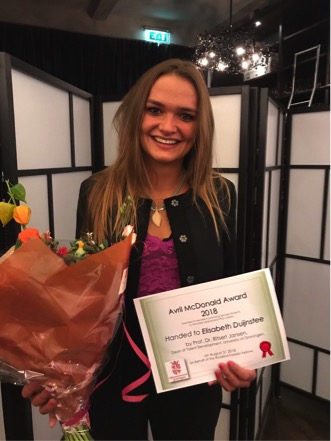Top Master in Nanoscience student Elisabeth Duijnstee wins Avril McDonald Award
Elisabeth Duijnstee, graduating from the Topmaster on Nanoscience on September 7th, 2018, won one of this year’s Avril McDonald Memorial Fund awards. The price is awarded to female students who have recently finished or are close to finishing their master’s degree to develop a proposal for their own PhD project. The awards are spread across all faculties and research areas (each year, no more than one prize can be awarded to each faculty).

Elisabeth Duijnstee is 23 years old. She was born in Amsterdam and after finishing her high school in Eindhoven, she did a bachelors in Physics at the University of Groningen. During her studies in Physics, she was fascinated by the outstanding and often unrivalled properties of micro- and nanodevices, and she decided to continue in this field by doing the Topmaster in Nanoscience. For her master thesis, she spent 6 months at the University of Oxford in the photophysics and optoelectronics group of Prof. Dr. H.J. Snaith, and 4 months at the University of Groningen in the group of Prof. Dr. L.J.A. Koster. She finds the interdisciplinary nature of advanced materials for photovoltaic purposes highly interesting and of great importance for a sustainable future, and therefore, she will continue her work in condensed matter physics by pursuing a PhD at the University of Oxford.
The dawn of a new era in optoelectronic technologies has emerged with the recent studies on organic-inorganic hybrid halide perovskites. Their power conversion efficiency has increased substantially from 3.8% in 2009 to the current world record of 22.7%. Despite the extraordinary performances of perovskites due to excellent optoelectronic and material-specific properties, the presence of anomalous hysteresis in the current-density voltage characteristics is holding back their development, and consensus has been reached that mobile ions play a major role in the origin of hysteresis. In this collaborative effort between computational and experimental research, elaborated in the group of Prof. Dr. L.J.A. Koster (University of Groningen) and Prof. Dr. H.J. Snaith (University of Oxford), Elisabeth Duijnstee fabricated single crystal perovskites devices to extract the electronic and ionic conductivity, while trying to decouple the two from each other by localizing mobile ions in both time and space, using the purchased knowledge from computational studies.
More news
-
15 September 2025
Successful visit to the UG by Rector of Institut Teknologi Bandung
